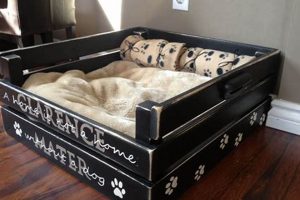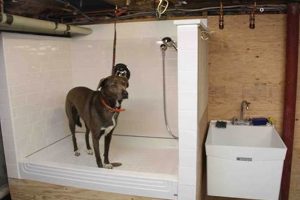Homemade canine enrichment devices, frequently constructed from readily available household items, offer mental stimulation and can alleviate boredom in domestic dogs. These contraptions challenge the animal to problem-solve in order to access a reward, typically a food treat. An example would be a repurposed plastic bottle with small holes, filled with kibble; the dog must manipulate the bottle to dispense the food.
Constructing these enrichment tools provides numerous advantages, promoting cognitive function, reducing destructive behaviors associated with inactivity, and fostering a stronger bond between owner and pet through interactive play. Historically, owners have improvised such devices as a cost-effective alternative to commercially available products, adapting materials and designs to suit their dog’s individual needs and capabilities.
The following sections will detail the types of materials suitable for creation, illustrate example designs, and provide safety guidelines to ensure the well-being of the animal during use.
Guidance for Constructing Canine Enrichment Devices
The subsequent recommendations aim to promote safety and efficacy when fabricating enrichment devices for canines using repurposed materials.
Tip 1: Material Selection: Prioritize non-toxic materials during construction. Avoid plastics containing BPA, sharp metal edges, or small parts that could detach and pose a choking hazard.
Tip 2: Structural Integrity: Ensure the device is robust enough to withstand chewing and manipulation. Reinforce weak points with durable tape or glue, verifying complete dryness and non-toxicity before use.
Tip 3: Gradual Introduction: Introduce the enrichment device to the canine in a controlled environment. Supervise initial interactions to assess the animal’s handling and prevent frustration or destructive behavior.
Tip 4: Difficulty Level Adjustment: Modify the device’s complexity based on the canine’s cognitive abilities. Start with simpler configurations and progressively increase the challenge as the animal demonstrates proficiency.
Tip 5: Hygiene Maintenance: Regularly clean enrichment devices to prevent bacterial growth. Disassemble components, if possible, and wash with soap and water, ensuring complete dryness before reassembling and reusing.
Tip 6: Observation and Adaptation: Continuously observe the canine’s interaction with the device. Adjust the design or materials if the animal displays signs of distress, disinterest, or potential danger.
Emphasizing material safety, structural soundness, and careful introduction promotes a positive and secure experience. Adapting the difficulty and maintaining cleanliness ensures the continued value and safety of enrichment devices.
The following section will address potential hazards and provide a comprehensive safety checklist to further ensure canine well-being.
1. Stimulation
Mental engagement, frequently termed stimulation, represents a pivotal element within the functionality of homemade canine enrichment devices. These devices necessitate cognitive activity beyond routine behaviors, offering a challenge that promotes mental acuity. The cause-and-effect relationship is direct: limited stimulation results in boredom and potential behavioral issues, whereas enhanced stimulation, facilitated via these challenges, contributes to a more balanced and content animal. Consider, for example, a dog left alone for extended periods. Lacking environmental challenges, destructive chewing or excessive barking may manifest. Introducing a puzzle feeder, which requires strategic interaction to dispense food, provides an alternative outlet, directing the dog’s energy towards a productive task.
The significance of stimulation as a component derives from the inherent need for cognitive exercise in canines. Just as physical activity maintains bodily health, mental challenges sustain cognitive function. Without such challenges, the dog’s mental abilities may stagnate, leading to lethargy or anxiety. A concrete application of this understanding lies in the construction of puzzle devices with varying difficulty levels. By tailoring the complexity to the dog’s cognitive capabilities, owners can provide an appropriate level of mental engagement, preventing frustration or discouragement. Regular rotation of different puzzle types further ensures continuous stimulation.
In summary, mental stimulation is not merely a beneficial add-on, but a fundamental requirement for canine well-being. Homemade enrichment devices serve as practical tools to fulfill this requirement. They provide a direct, accessible, and adjustable means of enhancing cognitive engagement, thereby mitigating behavioral problems and promoting a healthier, more balanced canine life. The challenge lies in correctly gauging the dog’s capabilities and adapting the puzzles accordingly, ensuring both stimulation and success. This connection ultimately highlights the practical significance of these cognitive challenges in addressing and averting negative behaviors stemming from a lack of appropriate engagement.
2. Engagement
Sustained interest and interaction, termed engagement, constitutes a critical factor in the efficacy of homemade canine enrichment devices. The effectiveness of these puzzles hinges on the dog’s willingness to interact with the device over a sustained period. Without sufficient engagement, the intended cognitive stimulation is unrealized, and the potential benefits are negated. The relationship is causative: a lack of engagement renders the puzzle ineffective, whereas consistent engagement yields the desired cognitive exercise and behavioral modification.
Engagement serves as a key indicator of a puzzle’s appropriateness for a specific dog. Factors contributing to engagement include the puzzle’s difficulty level, the reward offered, and the dog’s individual preferences. For instance, a puzzle that is too simple may quickly lose the dog’s interest, while one that is overly complex can lead to frustration and abandonment. The type of reward also plays a crucial role. High-value treats, such as small pieces of meat or cheese, are generally more effective at maintaining engagement than standard kibble. Furthermore, the dog’s breed, personality, and past experiences can influence their level of engagement with different types of puzzles. Practical application of this insight involves careful observation of the dog’s behavior during puzzle use. Signs of engagement include focused attention, persistent effort, and positive body language. Conversely, signs of disengagement include avoidance, frustration, and destructive behavior. By closely monitoring these indicators, owners can adjust the puzzle’s design, difficulty, or reward system to maximize engagement.
In summary, engagement is not merely a desirable outcome but an essential prerequisite for the successful utilization of homemade canine enrichment devices. It is a dynamic process influenced by multiple factors, requiring ongoing observation and adaptation. Ensuring sufficient engagement optimizes the cognitive benefits of the puzzle, promotes positive behavioral changes, and strengthens the bond between owner and dog. The primary challenge lies in accurately assessing the dog’s individual needs and preferences and tailoring the puzzle accordingly, guaranteeing continuous interest and interaction.
3. Enrichment
Canine enrichment encompasses environmental and behavioral modifications intended to enhance an animal’s psychological and physical well-being. Homemade cognitive challenges directly contribute to this enrichment by providing mental stimulation, promoting natural behaviors, and reducing the incidence of boredom-related problems. The cause-and-effect relationship is distinct: a deprived environment leads to behavioral issues, while a stimulating environment, fostered through engagement with these puzzles, mitigates such problems. Without purposeful enrichment, canines may exhibit destructive chewing, excessive barking, or general anxiety. Therefore, these cognitive devices serve as proactive tools for promoting a healthier existence.
The significance of enrichment as a component of DIY canine activities lies in its addressing of the inherent needs of the animal. These devices facilitate problem-solving, mimicking natural foraging behaviors that are often absent in domesticated settings. An example of this is a puzzle feeder designed to dispense food when manipulated correctly; this imitates the act of hunting or searching for food. In practice, owners can tailor the complexity of these challenges to suit the dog’s cognitive abilities and physical limitations. For instance, a senior dog might benefit from a simpler puzzle that requires minimal physical exertion, while a younger, more active dog may thrive on a complex, multi-step challenge. Furthermore, introducing a variety of puzzles ensures continuous cognitive stimulation and prevents the animal from becoming bored or desensitized.
In summary, enrichment constitutes an indispensable element in promoting canine well-being. Cognitive tasks represent a cost-effective and accessible means of providing such enrichment, addressing behavioral issues and fostering a healthier, more balanced life. The principal challenge lies in discerning the individual needs and preferences of the animal and adapting the puzzles accordingly, ensuring both mental stimulation and positive outcomes. This understanding highlights the practical value of these cognitive challenges in preventing adverse behaviors originating from insufficient engagement.
4. Problem-solving
The incorporation of problem-solving elements constitutes a primary function of homemade canine enrichment devices. These contraptions, by design, necessitate the animal to engage in cognitive processes to achieve a desired outcome, typically the acquisition of a food reward. The effectiveness of such devices directly correlates with the complexity of the problem presented: a rudimentary puzzle may offer minimal cognitive benefit, whereas a more intricate design promotes enhanced neural activity. Therefore, the problem-solving component serves as the core mechanism through which these canine tools exert their positive influence on mental acuity.
The prominence of problem-solving is underscored by the inherent need for cognitive exercise in canines. In domesticated environments, opportunities for natural problem-solving, such as hunting or foraging, are often limited. This deficiency can lead to boredom, frustration, and the manifestation of undesirable behaviors. Homemade enrichment devices offer a means to compensate for this deficit by providing structured opportunities for cognitive engagement. For example, a dog confronted with a puzzle ball must learn to manipulate the object in a specific manner to release the enclosed kibble. This process requires the animal to analyze the situation, formulate a strategy, and execute the necessary actions. Practical application stems from tailoring puzzle designs to match the individual dog’s capabilities. A novice puzzle solver might initially benefit from simpler contraptions, with complexity gradually increasing as the animal demonstrates proficiency. Moreover, diversifying the types of challenges presented prevents cognitive stagnation and maintains engagement over time.
In summary, problem-solving represents a non-negotiable component of homemade canine enrichment devices. These tools derive their value from stimulating cognitive function, addressing behavioral issues, and fostering a more balanced canine existence. The principal challenge resides in accurately assessing the dog’s cognitive abilities and adapting the puzzles accordingly, thus ensuring both mental stimulation and attainable success. The connection highlights the importance of these problem-solving challenges in mitigating negative behaviors that stem from a dearth of appropriate mental exertion.
5. Reward
Positive reinforcement, represented by the reward mechanism, is integral to the successful implementation of canine enrichment devices. The reward serves as the primary motivator, encouraging the dog to engage with the puzzle and persevere in its problem-solving efforts. The absence of a reward significantly diminishes the likelihood of sustained interaction and limits the potential cognitive benefits.
- Food Motivation
Edible treats are frequently employed as rewards in canine puzzles due to their innate appeal. The type, size, and palatability of the treat directly influence the dog’s motivation level. High-value treats, such as small pieces of meat or cheese, are typically more effective than standard kibble. The quantity of the treat should be proportionate to the effort required to solve the puzzle, ensuring a balanced reward-to-effort ratio.
- Timing and Delivery
The timing of the reward delivery is critical for reinforcing the desired behavior. The reward should be provided immediately upon successful completion of a step or the entire puzzle. This immediate feedback strengthens the association between the action and the positive outcome. The method of reward delivery can also vary, ranging from automatic dispensing within the puzzle to manual distribution by the owner.
- Variable Reinforcement
Employing a variable reinforcement schedule, wherein the reward is not provided consistently after each successful attempt, can enhance engagement and persistence. This unpredictable pattern prevents the dog from becoming complacent and encourages continued effort, even in the absence of immediate gratification. A variable schedule can involve altering the size or type of the reward, or occasionally withholding the reward altogether.
- Non-Food Rewards
While food is the most common motivator, non-food rewards can also be effective, particularly for dogs with strong play drives. These rewards can include verbal praise, petting, or the brief presentation of a favorite toy. Non-food rewards may be used in conjunction with food rewards to provide a more comprehensive reinforcement strategy, catering to the dog’s individual preferences.
The strategic application of reward systems is essential for maximizing the effectiveness of homemade canine puzzles. By carefully selecting the type, size, and timing of the reward, and by incorporating variable reinforcement, owners can create engaging and motivating experiences that promote cognitive development and behavioral improvement in their canine companions. Understanding individual dog preferences is key to tailoring the reward for optimal impact.
DIY Dog Puzzles
The following section addresses common inquiries regarding the construction and utilization of homemade canine cognitive enrichment devices.
Question 1: What materials are deemed unsuitable for constructing such devices?
Materials containing small, detachable parts pose a choking hazard. Plastics containing BPA and sharp metal edges are also to be avoided. Materials with known toxicity when ingested are strictly prohibited.
Question 2: How does one ascertain the appropriate difficulty level for a particular canine?
Observation of the dog’s behavior during initial interactions is crucial. Signs of frustration, such as withdrawal or destructive behavior, indicate the puzzle is too difficult. Conversely, rapid resolution suggests the device lacks sufficient challenge.
Question 3: What constitutes adequate hygiene maintenance for enrichment devices?
Regular cleaning with soap and water is necessary to prevent bacterial growth. Components should be disassembled, if possible, and thoroughly dried before reassembly and reuse. Dishwasher cleaning may be appropriate for some materials, contingent on their composition.
Question 4: How frequently should a canine engage with enrichment devices?
Frequency depends on the individual dog’s needs and the intensity of the puzzles. Supervised engagement for 15-30 minutes daily is generally recommended, but adjustment based on the dog’s energy levels and interest is advisable.
Question 5: Can enrichment devices replace traditional forms of exercise?
Enrichment devices supplement, but do not replace, traditional physical exercise. They primarily address cognitive needs, while physical activity remains essential for maintaining overall health and well-being.
Question 6: What is the procedure if a canine ingests a component of a homemade puzzle?
Immediate veterinary consultation is imperative. Providing the veterinarian with details regarding the ingested material’s composition aids in determining the appropriate course of action.
The key takeaways emphasize safety, observation, and adaptation. Constructing these devices requires careful consideration of materials and a commitment to monitoring the canine’s interaction.
The following section will explore advanced puzzle designs and modifications for specific canine needs.
DIY Dog Puzzles
This exploration of homemade cognitive challenges for canines has underscored their significance in promoting mental stimulation, engagement, enrichment, and problem-solving abilities. The effective construction and utilization of these “diy dog puzzles” necessitate careful material selection, gradual introduction, and continuous monitoring to ensure canine safety and well-being. Furthermore, tailoring the difficulty level and reward system to individual dog preferences is critical for sustained engagement and optimal cognitive benefits.
The development and implementation of “diy dog puzzles” represent a commitment to enhancing canine welfare through proactive mental enrichment. Further research into breed-specific cognitive needs and innovative puzzle designs will undoubtedly contribute to refining these tools and maximizing their positive impact on the lives of domestic dogs. Continued diligence in safety protocols remains paramount to prevent potential hazards and ensure the ongoing benefits of these enrichment activities.







